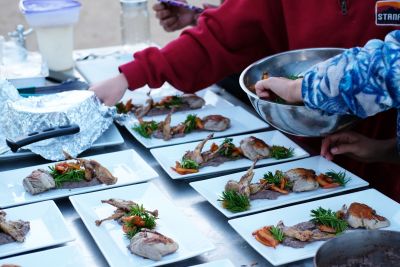Nibbling on petite samplings of quail, students in The Senior Reflection excitedly consider the acorn porridge and debate about the level of detail the chef – their classmate Alex Nguyen-Phuc, ’18 – should include in a printed menu to accompany the final meal. Although the class has taken on a temporary air of fine dining, it is actually part of the Biology Department at Stanford University. Designed for fourth-year undergraduates in the life sciences, The Senior Reflection is a year-long course that culminates in a work of art that explores a scientific topic.
Andrew Todhunter, lecturer in biology and health and human performance, and Susan McConnell, the Susan B. Ford professor in biology in the School of Humanities and Sciences, created The Senior Reflection in 2010. At the time, McConnell was co-chairing a study of the undergraduate experience and learned that about half of biology undergraduates completed a senior thesis. Understanding the value of these projects, this course was, in part, a way to appeal to students who wanted an alternative to more traditional capstone projects.
“The Senior Reflection enables students to think about what is important and meaningful in their majors,” said McConnell. “It’s an opportunity to produce an original piece of artwork that also capitalizes on their skills and knowledge.”
Each student in this course works with mentors in art and science and takes part in intense workshopping and critiques. At the end of spring quarter, the projects are exhibited to the public. This year’s projects were shown June 1 at the Sapp Center for Teaching and Learning.

Image credit: Claire Miles

Image credit: Claire Miles
Process over product
The paintings, sculptures, poems, stories, films, foods and performances created by the students mark the end of the class but the final products are not its aim. Success in The Senior Reflection is measured by student engagement and effort throughout the year.
“While the students produce extraordinary work, you aren’t expected to hit a particular bar,” explained Todhunter. “We are unabashedly concerned with process over product.”
This results in an intimate cycle of critique, creation and re-creation. By committing a significant amount of the first quarter to exercises that help the cohort bond, the instructors set up an environment where students can create deeply personal works and give honest, heartfelt feedback.
“In the beginning, I was absolutely terrified because my writing was very personal,” recalled this year’s teaching assistant, Mashbayar Tugsbayar, a graduate student in biomedical informatics at Stanford who took the class last year. “Everyone in the workshop was so open and honest and brave. You feel that they trust you, so you trust them as well.”
Mashbayar, who is originally from Mongolia, chose to attend university in the United States because they more often allow students to explore both science and art. But it wasn’t until The Senior Reflection that she began to engage seriously in art. Emboldened by her classmates to pursue the most personal of two potential projects, Mashbayar wrote a fantasy love story that explores the mindset of a person with depression.
Putting it all together
In the second quarter of the class, students work on securing mentors and bringing together their supplies. Split into two sections, students meet twice a week to workshop their ideas.
“I’m so glad I had so much support from everyone in the course. There were many times when I just wanted to give up,” said Shelly Xie, BS ’12, an alumna of the class. “I think it was a surprise for everyone when they saw the final product because it all came together at the end. Really.”
Xie produced a sand animation performance that educates people about schistosomiasis, a neglected tropical disease. Her mentor, San Francisco artist Jeremiah Barber, taught her about the art of live visual storytelling but, given the rarity of the art form, Xie also relied on learning from online videos. For the final project, Xie built her own light table and researched how to filter sand so she could use some that she collected at the beach near her home in Texas.
The students often work until the last minute to perfect their pieces for the exhibition, a celebratory event where they finally share their work with friends, family and the public. McConnell and Todhunter consistently remind students that these projects can have life beyond Stanford too, which has resulted in encore performances, publications and gallery showings. Since her time in The Senior Reflection, Xie has produced several more sand animations for the Pan American Health Organization.
Reflections on reflections
When the exhibition is over, students are encouraged to ruminate on their efforts and to write essays about their experience in the course.
“I didn’t realize how much I’d care,” said Nguyen-Phuc, whose project consisted of an eight-course dinner served May 4 at the O’Donohue Family Stanford Educational Farm, which highlighted ingredients native to California and her family’s immigration here from Vietnam. “I’ve invested a significant part of my time this year and happily so. It’s a defining part of my senior year.”
The students take away more than they could anticipate from the class, including lessons in workshopping, time management, empathy and, of course, their new and honed art skills. With a precious final product and fond memories, The Senior Reflection is a distinctive way to mark the end of a special chapter in a special place.
McConnell is also a member of Stanford Bio-X and the Stanford Neurosciences Institute.
Media Contacts
Taylor Kubota, Stanford News Service: (650) 724-7707; tkubota@stanford.edu